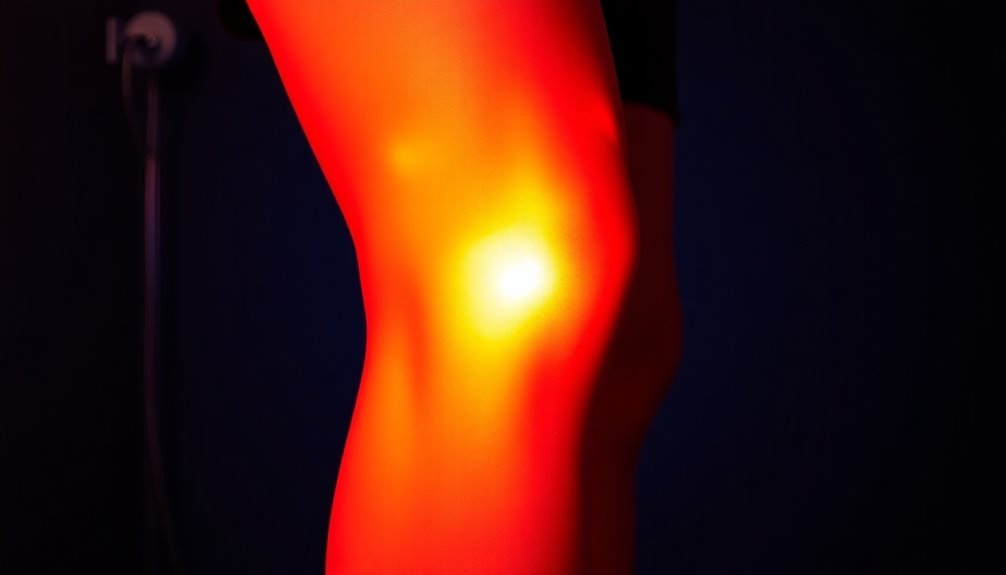Infrared therapy accelerates your muscle recovery in three powerful ways. First, it boosts your cellular energy production by stimulating mitochondria to create more ATP, giving your muscles the fuel they need to repair. Second, it reduces pain and inflammation by triggering endorphin release and interfering with pain signals to your brain, while the deep-penetrating light reaches 2-7 centimeters into affected tissues. Third, it enhances blood flow through vasodilation and new capillary formation, delivering essential nutrients to recovering muscles. Understanding these mechanisms can help you maximize the benefits of this cutting-edge recovery tool.
Boosting Cellular Energy Production

The cellular energy boost from infrared therapy revolutionizes how muscles recover after exercise. When you expose your muscles to specific wavelengths of red and near-infrared light (630-1200 nm), your mitochondria – the powerhouses of your cells – absorb this light and respond by producing more ATP, your body's primary energy currency.
This process, known as photobiomodulation, works through your mitochondrial respiratory chain, specifically targeting cytochrome c oxidase. Regular sessions of 3-4 times weekly help maintain optimal cellular regeneration. You'll experience enhanced cellular function as the increased ATP production energizes your muscle cells, accelerating their repair and recovery processes.
The boost in energy metabolism doesn't just stop at individual cells – it creates a cascade of beneficial effects throughout your muscle tissue. Your muscles will benefit from improved intercellular communication and enhanced blood flow as the therapy stimulates the formation of new capillaries. This means better oxygen and nutrient delivery to your recovering muscles.
Additionally, the therapy triggers the production of reactive oxygen species (ROS), which play a vital role in your body's healing and anti-inflammatory responses, making your recovery more efficient and thorough.
Reducing Pain and Inflammation
Working deep beneath your skin's surface, infrared therapy delivers powerful pain relief and anti-inflammatory effects through multiple mechanisms. It triggers your body's production of endorphins, natural painkillers that reduce discomfort, while simultaneously interfering with pain signals to your brain.
The deep-penetrating heat targets muscles, joints, and bones directly at the source of your pain. The therapy reaches 2-7 centimeters deep into tissues for maximum therapeutic effect.
You'll experience reduced inflammation as infrared therapy stimulates nitric oxide production, which relaxes your arteries and improves blood flow to damaged areas. This enhanced circulation helps remove toxins and metabolic waste products while delivering essential nutrients to speed healing.
The therapy also boosts collagen production, providing better joint support and reducing pain.
When you're dealing with post-workout soreness, infrared therapy can substantially reduce delayed onset muscle soreness (DOMS) and decrease lactic acid buildup. It's particularly effective when used before exercise, as it can improve your performance and minimize muscle damage.
You'll notice improved flexibility – up to three times normal range – and reduced joint stiffness. The therapy's ability to stimulate cellular repair processes helps your muscles regenerate faster, getting you back to peak condition sooner.
Enhancing Blood Flow

Through powerful vasodilation effects, infrared therapy dramatically enhances your blood circulation by triggering multiple physiological responses. When you use infrared therapy, it stimulates nitric oxide production, causing your blood vessels to dilate and vascular smooth muscle to relax. This combination reduces resistance in your blood vessels while promoting the formation of new capillaries through angiogenesis.
| Benefit | Mechanism | Impact |
|---|---|---|
| Improved Flow | Vessel dilation | Faster oxygen delivery |
| Better Circulation | Smooth muscle relaxation | Enhanced nutrient transport |
| Waste Removal | Increased velocity | Faster recovery |
| Temperature Rise | Vasodilation | Better tissue healing |
You'll experience increased blood flow velocity and improved microcirculation, which means more oxygen and nutrients reach your recovering muscles. The therapy's ability to enhance erythrocyte deformability lets your red blood cells move more easily through small vessels. Clinical studies confirm that consistent infrared treatments boost blood flow parameters and oxygen delivery to tissues. This increased circulation helps remove metabolic waste products while supporting ATP synthesis, which your muscles need for repair and growth. The therapy's effectiveness depends on proper treatment duration and intensity, so following recommended protocols is essential for achieving the best results.
Frequently Asked Questions
How Long Should Each Infrared Therapy Session Last for Optimal Results?
You'll want to start with 15-20 minute sessions and gradually increase to 30-45 minutes as your body adapts. For optimum results, maintain this routine 2-3 times per week with proper hydration.
Can Infrared Therapy Be Harmful if Used Too Frequently?
Yes, if you overuse infrared therapy, you'll risk burns, eye damage, dehydration, and skin irritation. Too frequent sessions can trigger excess inflammation and reduce healing benefits. It's essential to follow recommended treatment intervals.
What's the Ideal Distance Between the Device and Treated Area?
You'll get the best results by keeping your infrared device 6-12 inches from your skin for targeted treatment. If you're treating larger areas, you can position it 12-24 inches away for effective coverage.
Does Infrared Therapy Work Through Clothing or Require Direct Skin Contact?
While infrared therapy can penetrate clothing, you'll get the best results with direct skin contact. If you must wear clothes, choose light-colored, thin fabrics – but avoid dark or metallic materials that block penetration.
Are There Specific Wavelengths Better Suited for Different Types of Muscle Recovery?
Yes, you'll want 630-700nm for superficial muscle healing, 700-1200nm for deep tissue recovery, 850nm for athletic performance enhancement, and 940nm for chronic pain and inflammation management in muscles.
In Summary
You'll find infrared therapy to be a powerful tool for speeding up your post-workout recovery. By increasing your cellular energy production, lowering inflammation, and improving blood circulation, you're giving your muscles the best chance to rebuild and strengthen. Whether you're an athlete or fitness enthusiast, adding infrared therapy to your recovery routine will help you bounce back faster and train more effectively.





Leave a Reply